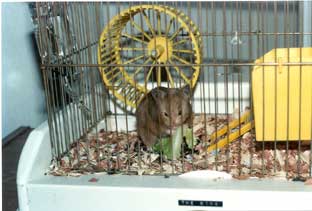
Return to my Homepage
Volume 13, Number 2. August 15 - August 21, 1996
COVER STORY

|
|
|
Live Fast, Die Young
The Short, Sweet Life of Hamsters
by Harry Kloman
There's just no other way to say it: Rascal was a stud, an honest-to-God macho man who drove women wild. He fathered 98 children in his lifetime, and probably a few more I didn't have time to count before their mothers ate them.
When you belong to a species that only lives for two years, you have to make babies as fast as you can, and you have to make sure every baby grows up to be a breeder. Hamsters gestate in 16 days, leave home in four weeks, and start having their own babies at three months. Female hamsters go into heat every four days; male hamsters, like the males of most species, are always ready.
In fact, Rascal's feat was limited only by the number of times I could afford to put him with a female waiting to be bred, although I occasionally loaned him out for stud service. When I was 12 and 13, I usually had two or three females at a time and one or two males. For a child who wanted to be a veterinarian, it was ideal: I kept the adult hamsters as pets and sold the babies to pay for supplies. My hamsters even had their 15 minutes: When I was in eighth grade, local TV star Ricki Wertz came to my home with her famous dog (and co-star) Copper Penny to buy a hamster.
I've often been without a hamster since junior high. But every few years I dust off the old cage and fill it.
My current hamster, Brian, is a mature rodent. He'll be 2 at the end of September, and I fear he'll never see another Christmas. He doesn't run his wheel any more, but he does like to climb to the top of his cage and gnaw on the metal bars. Rascal, Griff, Beast, Brian and some whose names I've forgotten have been gnawing on those same metal bars for a quarter century.
Hamsters first arrived in America in the mid-1950s. They came from the Arabian desert, where they slept during the hot days and forraged for food during the cooler nights. Despite decades of being bred in captivity, they remain nocturnal.
Happiness for a hamster means having more food than you can eat at a sitting so it's there when you need it. Their name comes from the German verb "hamstern," which means "to hoard." They belong to an elite group of rodents with internal cheek pouches that run the length of the face. When you feed them, they usually fill their pouches and take the food back to their nest, where they eat when they feel hungry.
I fear that hamsters have a bad reputation among pet owners. I always hear people ask, "Don't they bite?" Well, sometimes. But so do dogs and parakeets. It's important to handle young hamsters daily so they'll grow up to be gentle pets. For the first month you have them home, they'll scamper away when you try to pick them up. But after a while they become accustomed to your grasp and even come to the bars of the cage when they hear your voice.
Hamsters come in many colors, and my favorite has always been what used to be called "blue," but which is now usually called gray or black. I prefer males to females because females tend to be a bit high-strung. Males are bigger, which gives you more to hold when you take them out of the cage. And because males are stronger, their in-cage gyrations tend to be more amusing.
Every night, Rascal would hang from his arms and catwalk across the top of his cage. Every few minutes he'd crash to the floor. He could climb carpeted stairs, fill his pouches to half the size of his body, and get any female hamster pregnant, even a female left barren by Rascal's own father.
Alas, old Brian has never experienced the pleasures of the flesh. He rarely hangs from the top of his cage, and I have no carpeted stairs for him to climb. But he has a tendency to curl up on my lap and fall asleep, which is just about as adorable as a hamster can get.
Return to my Homepage